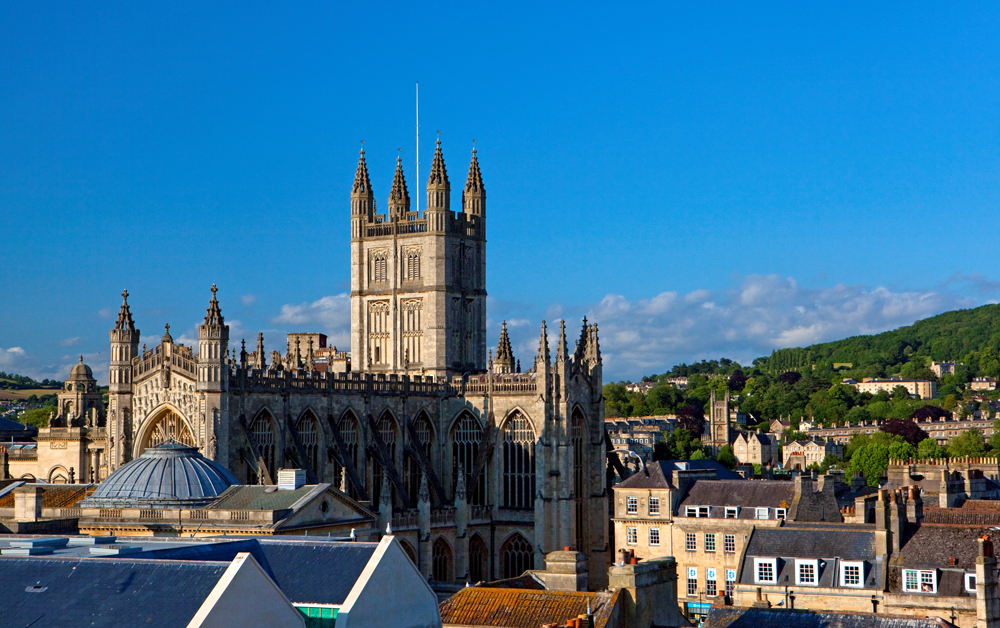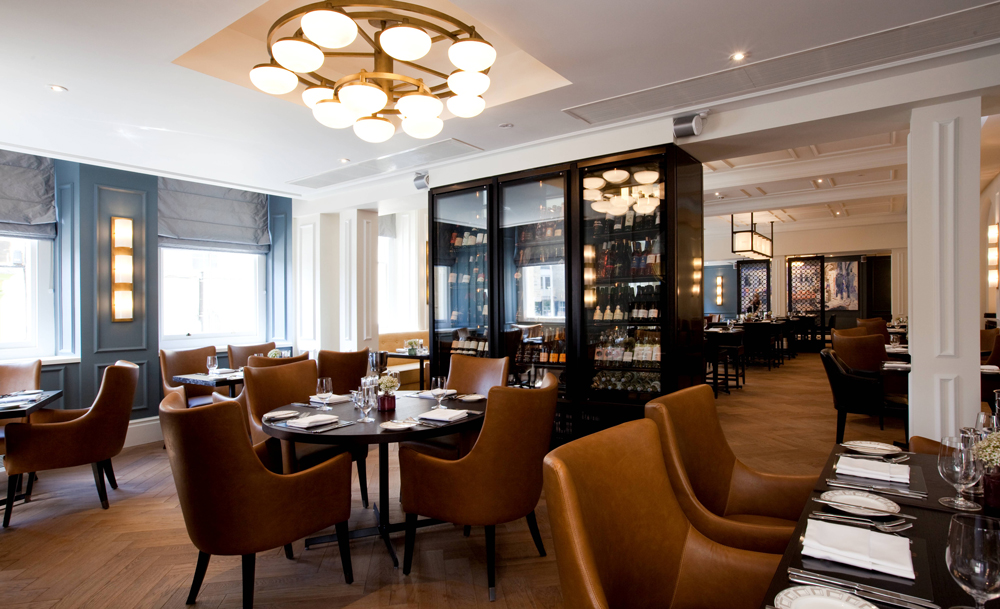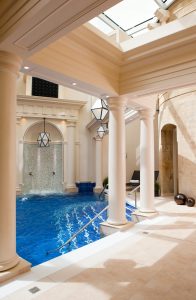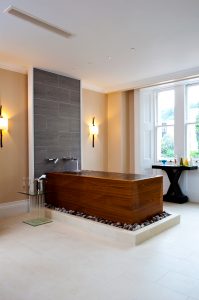
Visiting many hotels and spas around the world, I recently visited one of the wonders of the world in hotels incorporating real spa water, from natural springs. Bath is a World Heritage site, with unique waters from three springs. The question is: are there more springs still not tapped into?
Gainsborough Bath Spa in Bath, is a hotel that captures the Georgian setting, transferring it into the modern high-tech world, where tradition are still adhered to and hospitality really does matter. It took four years to build, including planning permission, which is exceptionally difficult to get in Bath, because the nature of the city, it most certainly does the city proud. It is now a part of the tourist trail to visit and in the main area of all the locations to visit.
Bath is regarded as one of the Georgian architectural movements, which straddled the period from roughly 1714 to 1830, in America when it was adopted it was called Colonial Revival (details at the end of the article).
Over a number of years, I try to bring you different articles that sum-up the business of spas and hotels, well Bath is regarded as one of the most well-known spa cities in Britain and the only one with natural hot springs.

WATERS FLOW WITH HISTORY
In the UK there are only 3 hot springs. It is established where they come from, it is generally thought that the Mendip Hills about 15-20 miles from Bath is the place to look. Bath is exceptional, as being the only natural thermal spa. Over the years it has had different names: Aquae Sulis, Caer Badon, Hat Bathu and finally Bath Spa. Going back into history it is said that Bladud, son of Ludhudibra’s father of King Lear, he was grateful for the bubbling hot springs, as they healed his leprosy. Archaeological proof goes back to 8,000 years BC; even today geologists are unsure where the hot springs originate.
Thermae Bath Spa was opened in August 2006, a ten-year project, supported by the residents of the City. The British Lottery awarded a $7.78 million grant to the City.
Prince Bladud son of King of the Britons contracted leprosy travelling in ancient Greece. He became a swineherd, tending his pigs in a valley where hot water bubbled from the ground.
He observed that his pigs had become free of scabs after wallowing in the muddy mire. So Bladud decided to do the same, he found it cured him.
Could this be true or false? Draw your own conclusions.
Celtic tribess of pre Britain often referred to, as Celts were great believers in the water to cure illnesses.
The Roman Bath still lies beneath the Roman Spa. In the 4th century the development comprised Aquae Sulis Baths, Sweat Rooms, and at least five hot and cold baths. It has been suggested the word spa is an acronym derived from the Latin phrase Salis Per Aquae, meaning health through water.
The end of Roman occupation arrived in the 4th century; a number of towns were abandoned, as native Britons were sent west. In Britain when the Romans arrived they were not for bathing, the whole area fell into ruins.
When Queen Elizabeth visited, about 1558 and about this time a new bath was built known as the Queens Bath. Also The Hospital of St John’s was rebuilt and enlarged, funded by a national collection, NOT the National Lottery. Royal Assent was given to the poor peoples use of the Baths.
Charles I visited Bath, Catherine of Braganza bathed in the Cross Bath whilst visiting Charles II. The famous diarist of the day Samuel Pepys also bathed, he was like a gossip column person of the day. He would be an expert tweeter.
There is so much history to tell. Hot Bath Pump Room opened in what is now the Spa Visitors Centre.
In 1939 came the end of regular bathing. The funding by the British National Service in 1976 was withdrawn and in 1978 a bug was discovered in the water and swimming was banned.
In August 2006 the new Thermae Bath opened. It was very long project to complete, designed by Sir Nicholas Grimshaw with his spectacular glass and stone cube holding a mirror to the City’s past. You can bathe in a rooftop pool overlooking the City no matter what the weather, truly invigorating.
Gainsborough Bath Spa was originally the Royal United Hospital and Belliott’s Hospital, designed by the well-known architect of the time John Pinch.
The hospital closed in 1932 then it became a home of Bath College of Art and Design. Thomas Gainsborough was famed portrait artist and central figure then in Bath Society circles. He was well known for painting portraits of the rich and famous residents. The hotel itself is the product of five buildings making it difficult to alter because of planning constraints. The outside of the building has a lightening scheme to the Georgian era. City Council saw the great benefits of Spa, Pump Room and the surrounding areas. Rebuilding the area, with great attention paid to the architecture of the period.
The design company who has done a remarkable job on the old hospital building is Champalimauld Design out of New York. As they say each building they design has individual character through extraordinary design. Bespoke luxury developments.
Alexander Champalimauld founder of the company has captured a very special aurora. Starting in 2010 they joined forces with YTL Hotels to design The Green Leaf Nigeko Village, Hokkaido, Japan. The New York Company, understands the Malaysian Management Group, their culture and strategy. YTL Group has business interests in Singapore, Indonesia, Australia, Japan and China. Also in construction, utilities and hotels, it is their first venture into Britain.
In Malaysia it is listed on the Bursa Malaysia Securities as one of the largest companies and now a listing on the Tokyo Stock Exchange, founded in 1955.

GEORGIAN PERIOD RECEPTION
The company worked with major constraints of the heritage of the buildings, adapting their quirks and often, unexpected features. The lobby is a Georgian history story in the entrance, the Lobby is elegant, and the central staircase could quite easily be in a period house set in Georgian times.
Very noticeable is a cascading lamp sculpture that descends, from the uppermost level to the spa reception on the lower level. In Reception, in keeping with the period of time is a Sedan chair, very fashionable in London and Bath, and easy to carry by men through the narrow streets of Bath. Owners use to keep them in their hallways, visitors to the spa could travel in one to use the spa. (Sedan is named after a place in France.)
The artwork I most certainly am impressed. Across one wall in the restaurant, is of modern art. Modern art painting very unique by the Bath College of Art and Design, who have supplied a number of paintings from students.

STONE IS A REFRESHING CHANGE THAN MARBLE
Bath stone is world famous from quarry’s in the Mendip Hills. It is as famous as the marble from Italy. City is built on the stone, with a glorious Abbey in the stone.
You will find the spa is housed in inter-linking Classical style buildings. The Gainsborough Bath Spa is unique in many ways and is the only hotel in Britain with direct access to natural thermal waters. The spa area has three therapeutic pools set within an atrium flooded with natural light. Within the hotel from your bedrooms you have access to the spa waters. The spa is housed in Classical-style buildings in what is called honey-toned Bath stone. It makes a great change from marble, which is used frequently, also helps with the local economy. The reception area of the spa is compact and the stone gives the spa a bright outlook.
There are ninety-nine guest rooms and suites in a number of styles.
Fine dining is order of the day. Michelin world acclaimed German chef Johann Lafer, he is known for his TV presence on Germany TV, and fresh local products are cooked in innovative ways. The restaurant has seating for 94, with butterscotch-colored leather seating in an eye-catching setting.
Spa treatments are very different, split-up into different categories:
Thermal Water Range
Organic Range
Traditional Spa Village Classics
Aquatic Body Therapy
Massages
The Wonder of Wellness Specialities
Private yoga, couples and personalised sessions
Bath Spa at the Gainsborough, is aligned with the Roman Bath springs. Visitors get a feel on the city’s water heritage. You can take the waters in, in the luxury of the spa, from dipping in three natural thermal pools of varying temperatures, traditional and infrared saunas, steam rooms, an ice alcove and I must say, very different relaxation areas, The ice sounds great on a day of 30 degrees outside.
The natural light with the light from the glass atrium, which is above the Bath House, is truly spectacular. The hotel has an abundance of light reflecting off the stonework. Great attention to detail has been paid to Gainsborough with the aptly named The Canvas Room. The hotels bar and dining room captures and draws you to view. Banqueting and conference facilities are available in The Somerset Room (up to 70 people can dine and attend meetings).
Staying at the hotel no two, guest rooms are the same. They range in size and style according to the layout of the floors.
There are many treatments to relax and pamper.

GINGER RENEWAL
Minerals are combined with ginger’s healing properties in an invigorating full-body exfoliation. Then more pampering is ordered, back, neck and shoulder massage with Organic Ginger Oil, while using warm healing stones. Next nourish and relax inside a warm cocoon while luxurious foot and pressure point scalp massage complete this head-to-toe service, 90 minutes of another world.
Traditional Spa Village Classics
Now for a Malaysian Experience, Malaysia is well known for its diverse healing customs born from the strong presence of Chinese. Using Malay, and Indian influence in the region. This deeply relaxing treatment celebrates these distinctive rituals. Using a warming spiced oil blend, traditional Malay massage utilizes techniques consisting of long kneading strokes that focus on the muscles, and various pressure points along the body. An Indian scalp massage increases the circulation to the head and neck believed to enhance clarity and focus. Then finished off with Chinese acupressure points and time honored egg rolling to tone the face.
CAMPUR-CAMPUR
The name Campur-Campur means a blending of varieties in Malay. Combining the best techniques of Malay and Thai massage, this upgraded Spa Village creation uses touch, tone and aromatherapy to give you a memorable experience. The scent of lemongrass and Pandan leaves fills the air as steamed herbs are pressed along the body using a traditional steam pouch. As they say, full-steam ahead.
Within the spa area is a replica of the original mosaic in the spa/hotel area. The hotel could not unearth the original mosaic as it remains below the surface with a mosaic floor to represent the original design pattern. A Replica has been reproduced. This does give an authentic to the mosaic design.
Meaning of Pandan, often referred to as Pandanus, screw pine or palm pine, herbaceous tropical plant found in South East Asia, in Chinese known as the fragrant plant, sweet unique aroma, used for many dishes.
There is so much do in Bath from the theatre, Jane Austen Centre and retail shopping is very enjoyable with all international Brands in precinct traffic free areas, great credit to a progressive Bath Council.
Meeting Peter Rollins, Director of Marketing and Communications, his view is that relaxing linked to the waters of Spa can include many things from going to the famous Bath theatre, films, visiting the Holburne Museum, the learning side of Bath with two excellent universities, to sports in many roles. Bath offers a great weekend break from London, just over two hours by train from London Paddington Station. The wonderful stone is for all to see in the landscape of the buildings. About 30minutes drive from Heathrow, the City is blessed with diverse places to visit.
YTL Group have given Bath a new leading attraction, The
*Bath is a UNESCO World Heritage Site
**Colonial Revival embraces the Georgian and Neoclassical styles, two examples buildings at the University of Delaware and Memorial City Hall in Auburn, New York
***Gainsborough Bath Spa is a member of the Leading Hotels of the World, a true mark of excellence.









